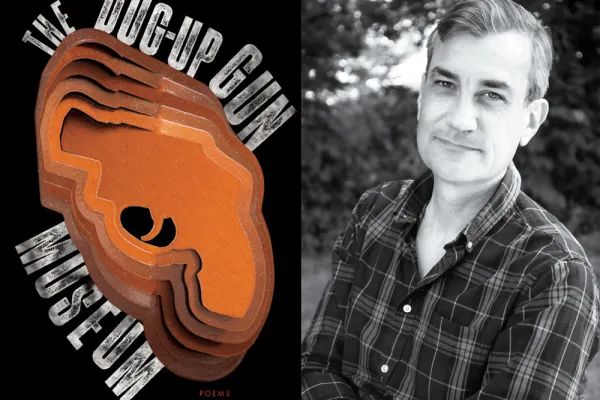Finding the Right Words
Research & Inquiry
Poetry Center Director Matt Donovan offers a poet’s perspective on America’s gun obsession

Published October 27, 2022
Matt Donovan’s latest book, The Dug-Up Gun Museum, is a powerful—and often astonishing—collection of poems that convey the unique stories of Americans who own guns and the tragedies linked to the prevalence of guns in the U.S. It’s not surprising that this book takes its title from a Wyoming museum that features exhibits dedicated to a legacy of guns and bullets. Here, Donovan, director of Smith’s Boutelle-Day Poetry Center, discusses why he set out across America to uncover the stories behind the country’s troubled history of gun violence.
How did this poetry project come about?
In the simplest terms, this project grew out of my ongoing concern about America’s gun violence. At the same time, though, I was also incredibly frustrated by the lack of any change in terms of both policy and rhetoric. Many of these poems grew out of a desire to initiate dialogue, but also, through travel and getting my boots on the ground, to try to understand our country’s obsession with guns.
Where did your travels take you?
I visited a number of far-flung locations, including cities like Cleveland and Chicago, as well as smaller towns, such as Newtown, Connecticut, and Cody, Wyoming. I toured museums like the National Firearms Museum, which is located at NRA [National Rifle Association] headquarters, and machine gun firing ranges in Las Vegas. I spent a day in Pennsylvania observing an annual paintball reenactment of D-Day, and, after learning that I wouldn’t be allowed to attend a military simulation at Fort Hood, I had my first-ever undercover poet experience when I enlisted as a participant.
What was that like?
Personally, I found the idea of playing war more than a little embarrassing, and I took every opportunity I could to avoid active battle situations and instead linger at the edges to ask questions and hear tales. For me, the big takeaway was that the whole experience served as a recruitment tool, with organizers and “squad leaders” taking every possible opportunity to glamorize and fetishize the tropes of war.
With this collection of poems, is there one story being told or thousands of stories? And why did you want to be the storyteller?
That’s an interesting question. I see this collection as a kind of portrait of America through the lens of guns, and, as such, hope that the poems, which were fueled by my interviews, do justice to some of the stories that people were generous enough to share with me. In many of these pieces, I’m not trying to be the singular storyteller so much as trying to let someone else’s story and voice come through.
“I’m a proponent of authentic dialogue,” Donovan says.
This work draws from numerous sources: history, the tourism industry, the news. When you’re working with so much source material, how do you know when it’s time to stop gathering information for a particular idea and sit down, be still, and actually write a poem?
Whenever I traveled somewhere during the course of developing this project, I always hoped to speak to a wide range of people and, through notetaking and experiences, amass as much content as possible. Gradually, though, during the later writing process and those moments of tranquility that you’re describing, there would be a gradual distillation, during which those stories, images, and experiences were whittled down. To be honest, there were so many unforgettable encounters and conversations that I still think about, but which unfortunately I wasn’t able to include in the final version of the book.
Was there a particularly meaningful encounter you had during your travels? Did you run into resistance from people with whom you spoke?
I think all the time about conversations I had with people—incredibly kind, brave, and generous people from places such as Sandy Hook Elementary School and Columbine High School—who were willing to share their stories with me, and who had lost children to gun violence, or were survivors of gun-related trauma. I also think frequently about the gun owners who were willing to speak with me. I was often reminded of my own stereotypes regarding people who own guns in America. The vast majority are responsible citizens who are also deeply concerned about the violence plaguing our country. I’m a proponent of authentic dialogue and remain grateful to the folks on both sides of the issue who were willing to speak with me.
I was struck by the sad resignation of this line in the poem “Thousands or Millions of Tiny Dots of Varying Size”: “here I am speaking to you within the silence of a poem/ which is not much more than a form of prayer/we’ve heard too many times that makes/ nothing change.” Who are you talking to with these poems?
I’m definitely talking back to that phrase “thoughts and prayers,” which has become such an enraging cliché as a response to gun violence, but I suppose I’m also admitting the risk for poetry itself to seem cloistered and ineffectual. That said, it seems important to me that the piece you’re quoting is placed early in the collection, which I hope affords an opportunity for these poems, as the collection unfolds, to offer something beyond the same familiar patterns of discourse around guns. Ultimately, I also think there’s an implicit question in those lines: Are words sufficient to enact meaningful change?
This story appears in the Fall 2022 issue of the Smith Alumnae Quarterly.
Donovan traveled across America to gather stories for his new book. Photograph of Donovan by Gabrielle Russomagno